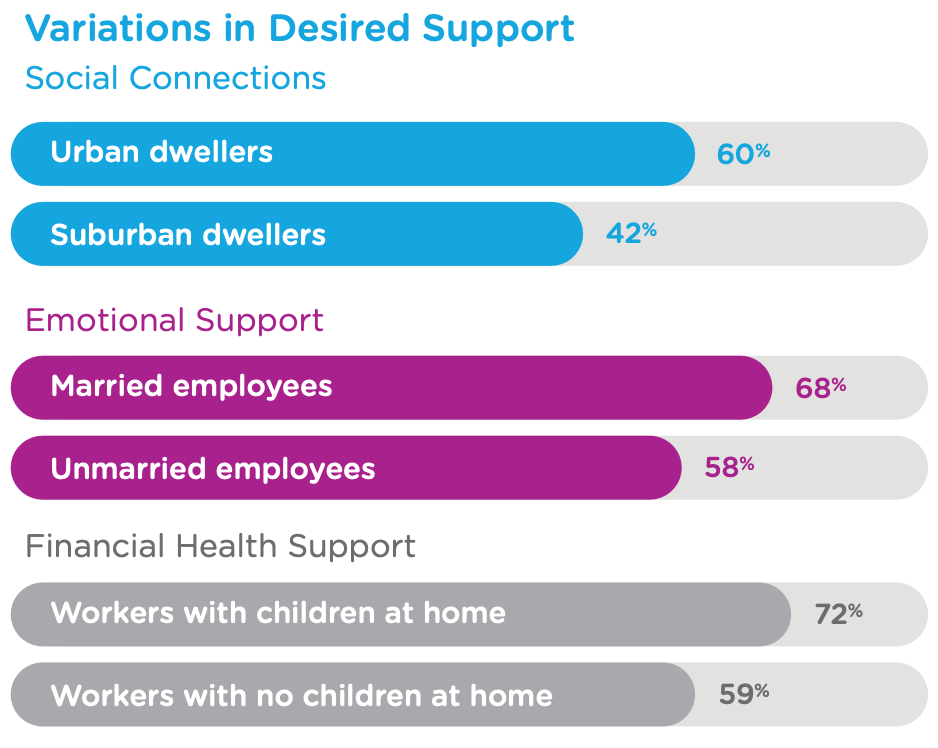Organizations recognize that offering wellness benefits helps attract and retain employees, as employees want and expect their companies to help with their well-being. Despite this seeming meeting of the minds, employers are still not offering the support employees want most, according to a recent survey of 1,000 employees in the United States.
Fifty-six percent of the employees surveyed said the support their companies offered was irrelevant, and 80% said they would be likely to participate in wellness programs if they were more targeted to their needs. Compounding the disconnect, most employees don’t know where to find the health and wellness resources that the company offers. Only 16% of employees strongly agreed that they knew how to find the available resources.
What Do Employees Want?
Employees in the survey said their most pressing wellness needs were:
- Financial stability
- Healthy eating habits
- Positive relationships for work and personal life
- Physical activity
- Adequate sleep
- Manageable stress level
- Control or manage existing health condition
- Find a higher purpose
In addition, employees said these aspects of a wellness program were important.
Personalized Programs
 Personalization is key to making a wellness program relevant, the study revealed. Employees in different demographics have different needs. For example, 72% of employees with children at home wanted financial support compared to only 59% of employees with no children. Likewise, 60% of employees who lived in the city wanted support with social connections while only 42% of those living in the suburbs agreed. These differences emphasize why companies must offer various benefits to meet the needs of diverse segments of employees.
Personalization is key to making a wellness program relevant, the study revealed. Employees in different demographics have different needs. For example, 72% of employees with children at home wanted financial support compared to only 59% of employees with no children. Likewise, 60% of employees who lived in the city wanted support with social connections while only 42% of those living in the suburbs agreed. These differences emphasize why companies must offer various benefits to meet the needs of diverse segments of employees.
Non-Cash Incentives
Beyond personalizing wellness offerings, companies also offer incentives to increase participation. Although cash rewards are often used, non-cash incentives can also be a powerful motivator. According to the survey, extra vacation time, flexible work schedules, and wellness benefits, such as a gym membership, were highly desired by employees. To be most effective, companies should offer incentives their employees value most.
Stress Management
Stress at work remains a source of concern, particularly for millennials. More than half of millennials say they have seriously considered changing jobs because of the level of stress in the current position. Despite the prevalence of stress, only 33% said their companies offer stress management programs. Companies are beginning to look at how environmental and cultural aspects can minimize stress, but there is still more work to be done.
Company-wide Support
Employees felt that when it came to well-being, their direct managers supported them, but company-wide initiatives were hard to find. This could be due to a lack of communication through the company layers and could possibly be addressed by compiling all resources and making them easy to access.
Getting Wellness Programs Right
Employers spend an average of $742 per employee per year on wellness. Offering programs that are irrelevant or that employees are unaware of leads to low participation and frustration, resulting in a waste of time and money for both the employer and employee.
Even as this survey provides insight on what 1,000 employees want in a wellness program, this list is not the be-all and end-all for every company. Instead, wellness leaders should closely examine what makes sense for their employee base and tailor those benefits and incentives accordingly.












